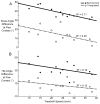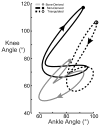High-speed X-ray video demonstrates significant skin movement errors with standard optical kinematics during rat locomotion
- PMID: 19900476
- PMCID: PMC2814909
- DOI: 10.1016/j.jneumeth.2009.10.017
High-speed X-ray video demonstrates significant skin movement errors with standard optical kinematics during rat locomotion
Abstract
The sophistication of current rodent injury and disease models outpaces that of the most commonly used behavioral assays. The first objective of this study was to measure rat locomotion using high-speed X-ray video to establish an accurate baseline for rat hindlimb kinematics. The second objective was to quantify the kinematics errors due to skin movement artefacts by simultaneously recording and comparing hindlimb kinematics derived from skin markers and from direct visualization of skeletal landmarks. Joint angle calculations from skin-derived kinematics yielded errors as high as 39 degrees in the knee and 31 degrees in the hip around paw contact with respect to the X-ray data. Triangulation of knee position from the ankle and hip skin markers provided closer, albeit still inaccurate, approximations of bone-derived, X-ray kinematics. We found that soft tissue movement errors are the result of multiple factors, the most impressive of which is overall limb posture. Treadmill speed had surprisingly little effect on kinematics errors. These findings illustrate the significance and context of skin movement error in rodent kinematics.
(c) 2009 Elsevier B.V. All rights reserved.
Figures









References
-
- Alexander EJ, Andriacchi TP. Correcting for deformation in skin-based marker systems. Journal of Biomechanics. 2001;34:355–61. - PubMed
-
- Anon . Washington, DC: U.S. Government Printing Office; 2001. Annual Report on Animal Welfare Act (AWA) Administration and Enforcement Activities In USDA.
-
- Bain JR, Mackinnon SE, Hunter DA. Functional evaluation of complete sciatic, peroneal, and posterior tibial nerve lesions in the rat. Plast Reconstr Surg. 1989;83:129–38. - PubMed
-
- Ballermann M, Tse AD, Misiaszek JE, Fouad K. Adaptations in the walking pattern of spinal cord injured rats. J Neurotrauma. 2006;23:897–907. - PubMed
-
- Banks SA, Fregly BJ, Boniforti F, Reinschmidt C, Romagnoli S. Comparing in vivo kinematics of unicondylar and bi-unicondylar knee replacements. Knee Surg Sports Traumatol Arthrosc. 2005;13:551–6. - PubMed
Publication types
MeSH terms
Substances
Grants and funding
LinkOut - more resources
Full Text Sources
Other Literature Sources

